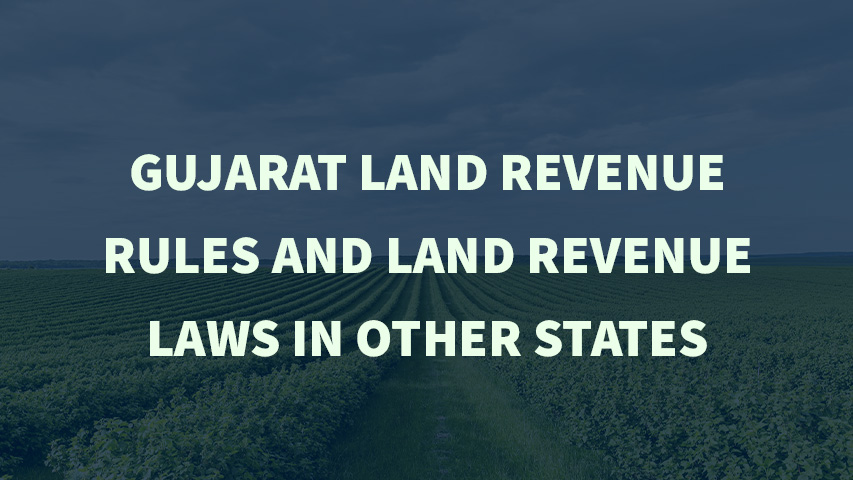
A Comparative Analysis of the Gujarat Land Revenue Rules and Land Revenue Laws in Other States
The land revenue system plays a crucial role in agricultural economies, as it determines the basis for taxation and land ownership. It sets the ground rules for land administration and revenue collection, ensuring economic stability and fostering agricultural development. This article aims to provide a comprehensive comparative analysis of the Gujarat Land Revenue Rules with land revenue laws in other Indian states. By examining the similarities and differences, we can gain a better understanding of land governance practices and identify areas where improvements can be made.
Contents
The land revenue system plays a crucial role in agricultural economies, as it determines the basis for taxation and land ownership. It sets the ground rules for land administration and revenue collection, ensuring economic stability and fostering agricultural development. This article aims to provide a comprehensive comparative analysis of the Gujarat Land Revenue Rules with land revenue laws in other Indian states. By examining the similarities and differences, we can gain a better understanding of land governance practices and identify areas where improvements can be made.
Contents
1. Land Revenue Laws in Gujarat
2. Comparative Analysis
2. Comparative Analysis
3. End Note
Land Revenue Laws in Gujarat
The Gujarat Land Revenue Rules (GLRR) were introduced in 1972 to govern land revenue administration in the state. These rules specify various procedures and mechanisms for determining landholdings, taxation, and revenue collection. Under the GLRR, land is classified into different categories based on its productivity and potential for cultivation. The revenue payable on agricultural land in Gujarat is determined through periodic revisions known as survey settlements.
Most states in India have their separate land revenue laws, and Gujarat is no exception. The primary objective of these laws is to regulate the collection of revenue, maintain land records, and ensure effective land management for agricultural purposes. In Gujarat, the GLRR has been instrumental in streamlining land administration and revenue collection processes, but it is essential to analyze its effectiveness in comparison to land revenue laws in other states.
Comparative Analysis
Land Classification
The classification of land is a crucial aspect of land revenue laws, as it determines the taxation rates and revenue payable by landholders. Gujarat categorizes land into different classes based on its productivity, irrigation facilities, and agricultural potential. In contrast, some states have simpler classifications based on the size of the landholding, regardless of its productivity. This difference in land classification can lead to variations in revenue collection methods and burden on landholders.
Revenue Assessments
Gujarat follows a system of periodical survey settlements to revise revenue assessments. Under this system, landholders are required to provide the necessary information and declarations concerning the land they possess. Revenue is then calculated based on various factors such as the land's productivity, irrigation facilities, and market value of crops. Other states employ a similar approach, but there may be variations in the frequency of assessments and the specific factors considered.
Land Records and Documentation
Maintaining accurate land records is vital to ensure transparency and effective land administration. In Gujarat, the GLRR mandates the maintenance of detailed records, including cadastral maps, mutation entries, and revenue accounts. Similarly, other states have their systems for maintaining land records, including digitization efforts to enhance accessibility and accuracy. Comparing the land record systems of Gujarat with other states can help identify best practices and areas for improvement.
Land Tenure Systems
Land tenure systems differ across states due to historical and societal factors. Some states have a dominant tenancy system, while others emphasize proprietorship. Gujarat follows a dual system, recognizing both tenancy and ownership rights. However, the specific regulations regarding tenancy and land rights may differ between states. Comparative analysis can uncover issues such as gaps in ensuring tenancy security or excessive restrictions on land transferability.
Modernization and Technology Adoption
To enhance efficiency and transparency, many states have started adopting technology-driven solutions in land revenue administration. For instance, some states have implemented online systems for revenue payment, mutation entry, and digital land record access. Gujarat has also undertaken efforts in this direction, but comparing its progress with other states can provide insights into successful models for modernizing land revenue systems.
End Note
The land revenue system plays a critical role in sustaining agricultural activities and facilitating economic growth. Through a comparative analysis of land revenue laws, particularly the Gujarat Land Revenue Rules and those of other states, we can identify potential areas of improvement and exchange best practices. Land classification, revenue assessment methods, land record management, land tenure systems, and technology adoption are key factors to compare. This article can inform policymakers in Gujarat and other states to enhance land governance practices, fostering agricultural development and ensuring fair revenue collection.
